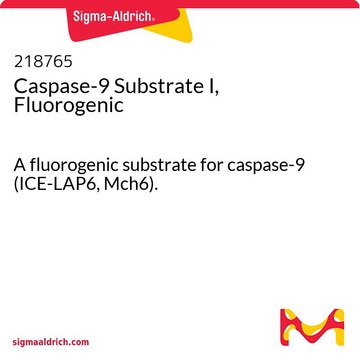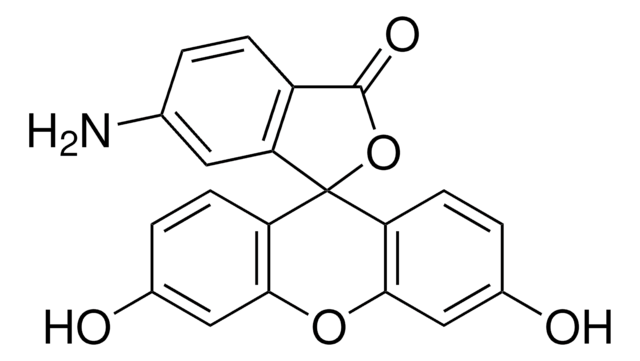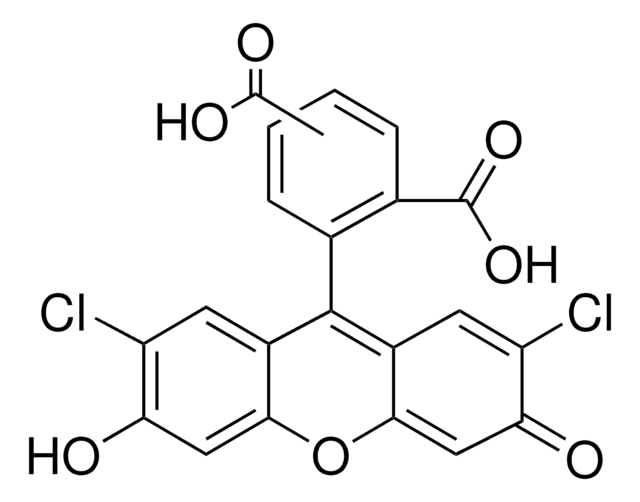추천 제품
제조업체/상표
Chemicon®
LentiBrite
Quality Level
기술
cell based assay: suitable
immunocytochemistry: suitable
immunofluorescence: suitable
single cell analysis: suitable
transfection: suitable
UniProt 수납 번호
검출 방법
fluorometric
배송 상태
dry ice
유전자 정보
human ... MAPRE3(22924)
일반 설명
Read our application note in Nature Methods!
http://www.nature.com/app_notes/nmeth/2012/121007/pdf/an8620.pdf
(Click Here!)
Learn more about the advantages of our LentiBrite Lentiviral Biosensors! Click Here
Biosensors can be used to detect the presence/absence of a particular protein as well as the subcellular location of that protein within the live state of a cell. Fluorescent tags are often desired as a means to visualize the protein of interest within a cell by either fluorescent microscopy or time-lapse video capture. Visualizing live cells without disruption allows researchers to observe cellular conditions in real time.
Lentiviral vector systems are a popular research tool used to introduce gene products into cells. Lentiviral transfection has advantages over non-viral methods such as chemical-based transfection including higher-efficiency transfection of dividing and non-dividing cells, long-term stable expression of the transgene, and low immunogenicity.
EMD Millipore is introducing LentiBrite Lentiviral Biosensors, a new suite of pre-packaged lentiviral particles encoding important and foundational proteins of autophagy, apoptosis, and cell structure for visualization under different cell/disease states in live cell and in vitro analysis.
EMD Millipore’s LentiBrite EB3-RFP lentiviral particles provide bright fluorescence and precise localization to enable live-cell analysis of microtubule plus-end dynamics in difficult-to-transfect cell types.
http://www.nature.com/app_notes/nmeth/2012/121007/pdf/an8620.pdf
(Click Here!)
Learn more about the advantages of our LentiBrite Lentiviral Biosensors! Click Here
Biosensors can be used to detect the presence/absence of a particular protein as well as the subcellular location of that protein within the live state of a cell. Fluorescent tags are often desired as a means to visualize the protein of interest within a cell by either fluorescent microscopy or time-lapse video capture. Visualizing live cells without disruption allows researchers to observe cellular conditions in real time.
Lentiviral vector systems are a popular research tool used to introduce gene products into cells. Lentiviral transfection has advantages over non-viral methods such as chemical-based transfection including higher-efficiency transfection of dividing and non-dividing cells, long-term stable expression of the transgene, and low immunogenicity.
EMD Millipore is introducing LentiBrite Lentiviral Biosensors, a new suite of pre-packaged lentiviral particles encoding important and foundational proteins of autophagy, apoptosis, and cell structure for visualization under different cell/disease states in live cell and in vitro analysis.
- Pre-packaged, fluorescently-tagged with GFP & RFP
- Higher efficiency transfection as compared to traditional chemical-based and other non-viral-based transfection methods
- Ability to transfect dividing, non-dividing, and difficult-to-transfect cell types, such as primary cells or stem cells
- Non-disruptive towards cellular function
EMD Millipore’s LentiBrite EB3-RFP lentiviral particles provide bright fluorescence and precise localization to enable live-cell analysis of microtubule plus-end dynamics in difficult-to-transfect cell types.
Microtubules are dynamic cytoskeletal filaments comprising a core of tubulin subunits flanked by structurally and functionally distinct termini, termed the plus-end and minus-end. The dynamic instability of microtubules, with cycles of growth and decay, occurs at the plus-ends and is mediated by a complex of microtubule plus-end tracking proteins (+TIPs). Key components of the +TIP complex are the end-binding proteins (EBs). Imaging of plus-end growth in live cells expressing EBs tagged with fluorescent proteins has contributed greatly to our understanding of microtubule dynamics.
EMD Millipore’s LentiBrite EB3-RFP lentiviral particles provide bright fluorescence and precise localization to enable live-cell analysis of microtubule plus-end dynamics in difficult-to-transfect cell types.
EMD Millipore’s LentiBrite EB3-RFP lentiviral particles provide bright fluorescence and precise localization to enable live-cell analysis of microtubule plus-end dynamics in difficult-to-transfect cell types.
애플리케이션
Fluorescence Microscopy Imaging:
REF52 cells were plated in a coverglass chamber slide and transduced with lentiviral particles at an MOI of 20 for 24 hours. After media replacement and 48 hours further incubation, cells were imaged live by oil immersion wide-field fluorescence microscopy. The EB3-RFP displays a punctate distribution characteristic of microtubule ends.
Immunocytochemistry Comparison and Inhibitor Analysis:
HeLa cells were plated in a coverglass chamber slide and transduced with lentiviral particles at an MOI of 20 for 24 hours. After 24 hours, media was replaced and cells were then further incubated for 48 hours. EB3-RFP displays a nearly complete overlap with EB3 detected by immunocytochemical staining with rabbit polyclonal anti-EB3 (EMD Millipore cat. no. AB6033).
Additional Cell Types:
MCF7 cells were transduced with EB3-RFP lentivirus as in Figure 1 at an MOI 40 for 24 hours, then stained for tubulin. EB3-RFP displays a punctate and short linear distribution. Immunocytochemical staining with a monoclonal antibody against α-tubulin (EMD Millipore Cat. No. 05-829) reveals the typical filamentous pattern of microtubules. Overlay of EB3-RFP (red), anti-tubulin (green) and DAPI (blue) demonstrates that EB3-RFP is localized to the microtubule ends.
Hard-to-transfect Cell Types:
Primary cell type HUVEC and Human mesenchymal stem cells (HuMSC) were plated in coverglass chamber slides and transduced with lentiviral particles at an MOI of 20 and 40, respectively, for 24 hours.
Time-lapse Imaging:
REF52 cells were plated in coverglass chamber slides and transduced with EB3-RFP lentiviral particles. Images were collected every 3 seconds for a total of 2 min. Shown here are 3 sequential frames; to see the entire sequence, please visit our Cell Structure-Biosensors page.
For optimal fluorescent visualization, it is recommended to analyze the target expression level within 24-48 hrs after transfection/infection for optimal live cell analysis, as fluorescent intensity may dim over time, especially in difficult-to-transfect cell lines. Infected cells may be frozen down after successful transfection/infection and thawed in culture to retain positive fluorescent expression beyond 24-48 hrs. Length and intensity of fluorescent expression varies between cell lines. Higher MOIs may be required for difficult-to-transfect cell lines.
REF52 cells were plated in a coverglass chamber slide and transduced with lentiviral particles at an MOI of 20 for 24 hours. After media replacement and 48 hours further incubation, cells were imaged live by oil immersion wide-field fluorescence microscopy. The EB3-RFP displays a punctate distribution characteristic of microtubule ends.
Immunocytochemistry Comparison and Inhibitor Analysis:
HeLa cells were plated in a coverglass chamber slide and transduced with lentiviral particles at an MOI of 20 for 24 hours. After 24 hours, media was replaced and cells were then further incubated for 48 hours. EB3-RFP displays a nearly complete overlap with EB3 detected by immunocytochemical staining with rabbit polyclonal anti-EB3 (EMD Millipore cat. no. AB6033).
Additional Cell Types:
MCF7 cells were transduced with EB3-RFP lentivirus as in Figure 1 at an MOI 40 for 24 hours, then stained for tubulin. EB3-RFP displays a punctate and short linear distribution. Immunocytochemical staining with a monoclonal antibody against α-tubulin (EMD Millipore Cat. No. 05-829) reveals the typical filamentous pattern of microtubules. Overlay of EB3-RFP (red), anti-tubulin (green) and DAPI (blue) demonstrates that EB3-RFP is localized to the microtubule ends.
Hard-to-transfect Cell Types:
Primary cell type HUVEC and Human mesenchymal stem cells (HuMSC) were plated in coverglass chamber slides and transduced with lentiviral particles at an MOI of 20 and 40, respectively, for 24 hours.
Time-lapse Imaging:
REF52 cells were plated in coverglass chamber slides and transduced with EB3-RFP lentiviral particles. Images were collected every 3 seconds for a total of 2 min. Shown here are 3 sequential frames; to see the entire sequence, please visit our Cell Structure-Biosensors page.
For optimal fluorescent visualization, it is recommended to analyze the target expression level within 24-48 hrs after transfection/infection for optimal live cell analysis, as fluorescent intensity may dim over time, especially in difficult-to-transfect cell lines. Infected cells may be frozen down after successful transfection/infection and thawed in culture to retain positive fluorescent expression beyond 24-48 hrs. Length and intensity of fluorescent expression varies between cell lines. Higher MOIs may be required for difficult-to-transfect cell lines.
Research Category
Cell Structure
Cell Structure
Research Sub Category
Cytoskeleton
Cytoskeleton
성분
EB3-TagRFP Lentivirus:
One vial containing 25 µL of lentiviral particles at a minimum of 3 x 10E8 infectious units (IFU) per mL. For lot-specific titer information, please see “Viral Titer” in the datasheet.
Promoter
EF-1 (Elongation Factor-1)
Multiplicty of Infection (MOI)
MOI = Ratio of # of infectious lentiviral particles (IFU) to # of cells being infected.
Typical MOI values for high transduction efficiency and signal intensity are in the range of 20-40. For this target, some cell types may require lower MOIs (e.g., HT-1080, human mesenchymal stem cells (HuMSC)), while others may require higher MOIs (e.g., human umbilical vein endothelial cells (HUVEC), U2OS, HeLa).
NOTE: MOI should be titrated and optimized by the end user for each cell type and lentiviral target to achieve desired transduction efficiency and signal intensity.
One vial containing 25 µL of lentiviral particles at a minimum of 3 x 10E8 infectious units (IFU) per mL. For lot-specific titer information, please see “Viral Titer” in the datasheet.
Promoter
EF-1 (Elongation Factor-1)
Multiplicty of Infection (MOI)
MOI = Ratio of # of infectious lentiviral particles (IFU) to # of cells being infected.
Typical MOI values for high transduction efficiency and signal intensity are in the range of 20-40. For this target, some cell types may require lower MOIs (e.g., HT-1080, human mesenchymal stem cells (HuMSC)), while others may require higher MOIs (e.g., human umbilical vein endothelial cells (HUVEC), U2OS, HeLa).
NOTE: MOI should be titrated and optimized by the end user for each cell type and lentiviral target to achieve desired transduction efficiency and signal intensity.
품질
Evaluated by transduction of HT-1080 cells and fluorescent imaging performed for assessment of transduction efficiency.
물리적 형태
PEG precipitation
저장 및 안정성
Storage and Handling
Lentivirus is stable for at least 4 months from date of receipt when stored at -80°C. After first thaw, place immediately on ice and freeze in working aliquots at -80°C. Frozen aliquots may be stored for at least 2 months. Further freeze/thaws may result in decreased virus titer and transduction efficiency.
IMPORTANT SAFETY NOTE
Replication-defective lentiviral vectors, such as the 3rd Generation vector provided in this product, are not known to cause any diseases in humans or animals. However, lentiviruses can integrate into the host cell genome and thus pose some risk of insertional mutagenesis. Material is a Risk Group 2 and should be handled under BSL2 controls. A detailed discussion of biosafety of lentiviral vectors is provided in Pauwels, K. et al. (2009). State-of-the-art lentiviral vectors for research use: Risk assessment and biosafety recommendations. Curr. Gene Ther. 9: 459-474.
Lentivirus is stable for at least 4 months from date of receipt when stored at -80°C. After first thaw, place immediately on ice and freeze in working aliquots at -80°C. Frozen aliquots may be stored for at least 2 months. Further freeze/thaws may result in decreased virus titer and transduction efficiency.
IMPORTANT SAFETY NOTE
Replication-defective lentiviral vectors, such as the 3rd Generation vector provided in this product, are not known to cause any diseases in humans or animals. However, lentiviruses can integrate into the host cell genome and thus pose some risk of insertional mutagenesis. Material is a Risk Group 2 and should be handled under BSL2 controls. A detailed discussion of biosafety of lentiviral vectors is provided in Pauwels, K. et al. (2009). State-of-the-art lentiviral vectors for research use: Risk assessment and biosafety recommendations. Curr. Gene Ther. 9: 459-474.
법적 정보
CHEMICON is a registered trademark of Merck KGaA, Darmstadt, Germany
Storage Class Code
10 - Combustible liquids
WGK
WGK 2
시험 성적서(COA)
제품의 로트/배치 번호를 입력하여 시험 성적서(COA)을 검색하십시오. 로트 및 배치 번호는 제품 라벨에 있는 ‘로트’ 또는 ‘배치’라는 용어 뒤에서 찾을 수 있습니다.
관련 콘텐츠
Fluorescent lentiviral particles encoding important GFP/RFP fusion proteins related to autophagy, apoptosis, and cell structure that enables live cell imaging.
자사의 과학자팀은 생명 과학, 재료 과학, 화학 합성, 크로마토그래피, 분석 및 기타 많은 영역을 포함한 모든 과학 분야에 경험이 있습니다..
고객지원팀으로 연락바랍니다.







